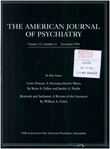Course of premenstrual syndrome symptom severity after treatment
Abstract
OBJECTIVE: Patients from a randomized, double-blind, placebo-controlled study of progesterone suppository treatment for premenstrual syndrome (PMS) were followed up to determine poststudy PMS symptom levels and medication use. METHOD: An average of 1 year after the end of the treatment study, 129 subjects were contacted for telephone interviews. All subjects met criteria for PMS before the progesterone suppository treatment, and their symptoms were confirmed by daily symptom reports throughout the study. The outcome measure at follow-up was the patient's global assessment of symptom severity, which was also rated by the subjects during the treatment study. The ratings at enrollment, end of study, and follow-up were compared. RESULTS: Only 27% of the subjects (N = 35) were taking medications for PMS at follow-up. Symptom severity at follow-up was less than at enrollment but greater than at the end of the study. CONCLUSIONS: Some of the improvement gained during treatment was maintained, but overall the subjects remained moderately symptomatic. Validation of the PMS condition, education, and support and caring may account for the symptom decreases during treatment, and the end of treatment and withdrawal of these conditions may account for the moderate return of symptoms.
Access content
To read the fulltext, please use one of the options below to sign in or purchase access.- Personal login
- Institutional Login
- Sign in via OpenAthens
- Register for access
-
Please login/register if you wish to pair your device and check access availability.
Not a subscriber?
PsychiatryOnline subscription options offer access to the DSM-5 library, books, journals, CME, and patient resources. This all-in-one virtual library provides psychiatrists and mental health professionals with key resources for diagnosis, treatment, research, and professional development.
Need more help? PsychiatryOnline Customer Service may be reached by emailing [email protected] or by calling 800-368-5777 (in the U.S.) or 703-907-7322 (outside the U.S.).



